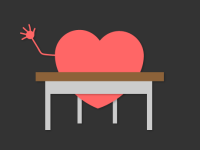Teaching Empathy: Are We Teaching Content or Students?
Teaching empathy is about teaching students, not content — how they feel about the incoming knowledge will ultimately determine how useful it is to them.
Right near the core of education, just past tolerance and just short of affectionate connectivity, is the idea of empathy. University of California Berkley's Greater Good Science Center explains empathy:
What Empathy Is and Is Not
Empathy is often confused with sympathy, which is a pretty extraordinary error depending on how tightly wound you are about these things (and whose definitions you stand behind). Dr. Brené Brown offers a divisive take on the difference: "Empathy fuels connections, sympathy drives disconnection."
This contrasts with Dictionary.com, which explains:
Dictionary.com marks just a slight discrepancy between the two -- sympathy requires less movement and merging of emotions, while empathy is entirely that.
The chemistry, subjectivity, and nuance of language aside, there is a clear handle for us as teachers. However large you see the distinction, they certainly have very different tones. Empathy is based in compassion, while sympathy is based in analysis.
Greater Good continues, clarifying:
Ideally, empathy would be the net effect of experience, which in classrooms is a matter of both process and knowledge. Students would learn to empathize rather than be taught to empathize, as a symptom of what they know. Why this is important is a matter of implication and language. Teaching someone to feel what others feel and sit with emotions that aren't their own couldn't be any further from the inherent pattern of academics, which is always decidedly other. Teaching always begins with detachment -- learn this skill or content strand that is now apart from you. Empathy is the opposite -- it starts in the other, and finishes there without leaving.
Formal Education vs. True Connection
In your classroom, there are dozens of natural sources of empathy. But what about authenticity? There's nothing worse than "schoolifying" something that a child actually needs to know. So much of great teaching is about packaging content so that students recognize it as something they need to know and can actually use, rather than something to do "because I said so, and you don't want a zero, do you?"
Here's one way to consider it. Without empathy, you're teaching content instead of students. The concept of teachers as primarily responsible for content distribution is a dated one, but even seeking to "engage" students misses the calling of teaching. To teach a child is to miss that child. You must understand them for who they are and where they are, not for what you hope to prepare them for. "Giving knowledge" and "engaging students" in pursuit of pre-selected knowledge are both natural processes of formal education -- and both make empathy hard to come by.
So where to start doing something different? How should you “teach it”? How will you know it when you see it? Is it different for different content areas, grade levels, genders, socioeconomic backgrounds, nationalities, or some other "thing"? Is this new-age mumbo jumbo, or a precise tool for a progressive teacher? How has the push of digital and social media into learning spaces emphasized the need for empathy -- or naturally reduced it?
Is empathy a skill that can even be taught, a "competency" that you should bullet-point in your lesson plan, something that requires pre-assessment? Or is it something fuller, something more persistent and whole? Scotty McLennan, the Dean for Religious Life at Stanford University, suggests:
The Human Face of Understanding
But pushed farther, it's not hard to see that empathy is both a cause and effect of understanding, a kind of cognitive and emotional double helix that can create a bridge between classroom learning and "real-life" application. Getting started with empathy in the classroom is a matter of first grasping it as a concept, strategy, and residual effect of knowledge and perspective. Heading over to Teaching Tolerance and ordering a bunch of posters and DVDs may be unnecessary -- at least at first. Internalizing how the idea of empathy can reframe everything that happens in your classroom -- your reason for teaching -- is a shift that will suggest a world of possibility for teaching lessons, activities, and strategies.
More than anything else though, empathy is a tone. Broken into parts, it is about self, audience, and purpose. It helps students consider:
- Who am I?
- Who is "other"? And how? In what functions and degrees?
- How do we relate? What do we share?
- What do they need from me, and I from them?
This leads to a staggering and often troubling question for all of us: "What should I do with what I know?"
